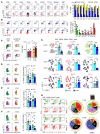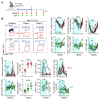Chronic SIV-Induced neuroinflammation disrupts CCR7+ CD4+ T cell immunosurveillance in the rhesus macaque brain
- PMID: 38470479
- PMCID: PMC11060742
- DOI: 10.1172/JCI175332
Chronic SIV-Induced neuroinflammation disrupts CCR7+ CD4+ T cell immunosurveillance in the rhesus macaque brain
Abstract
CD4+ T cells survey and maintain immune homeostasis in the brain, yet their differentiation states and functional capabilities remain unclear. Our approach, combining single-cell transcriptomic analysis, ATAC-Seq, spatial transcriptomics, and flow cytometry, revealed a distinct subset of CCR7+ CD4+ T cells resembling lymph node central memory (TCM) cells. We observed chromatin accessibility at the CCR7, CD28, and BCL-6 loci, defining molecular features of TCM. Brain CCR7+ CD4+ T cells exhibited recall proliferation and interleukin-2 production ex vivo, showcasing their functional competence. We identified the skull bone marrow as a local niche for these cells alongside CNS border tissues. Sequestering TCM cells in lymph nodes using FTY720 led to reduced CCR7+ CD4+ T cell frequencies in the cerebrospinal fluid, accompanied by increased monocyte levels and soluble markers indicating immune activation. In macaques chronically infected with SIVCL757 and experiencing viral rebound due to cessation of antiretroviral therapy, a decrease in brain CCR7+ CD4+ T cells was observed, along with increased microglial activation and initiation of neurodegenerative pathways. Our findings highlight a role for CCR7+ CD4+ T cells in CNS immune surveillance, and their decline during chronic SIV highlights their responsiveness to neuroinflammation.
Keywords: AIDS/HIV; Adaptive immunity; Inflammation; Neurological disorders; T cells.
Conflict of interest statement
Figures









Update of
-
CCR7+ CD4 T Cell Immunosurveillance Disrupted in Chronic SIV-Induced Neuroinflammation in Rhesus Brain.bioRxiv [Preprint]. 2023 Aug 31:2023.08.28.555037. doi: 10.1101/2023.08.28.555037. bioRxiv. 2023. Update in: J Clin Invest. 2024 Mar 12;134(9):e175332. doi: 10.1172/JCI175332. PMID: 37693567 Free PMC article. Updated. Preprint.
References
Publication types
MeSH terms
Substances
Grants and funding
LinkOut - more resources
Full Text Sources
Molecular Biology Databases
Research Materials

